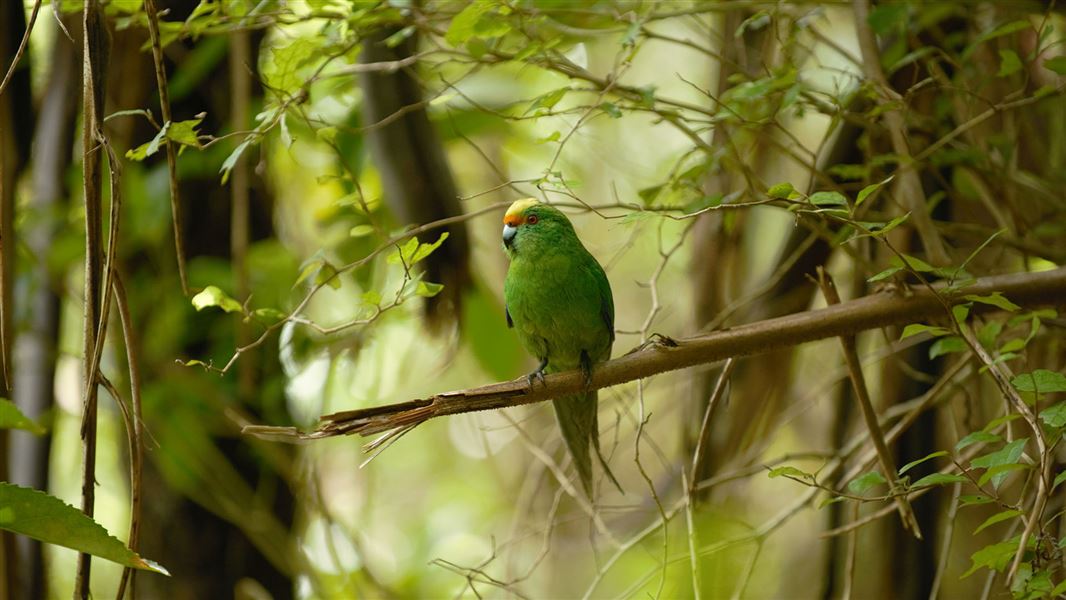Date: 23 May 2024
Department of Conservation Kākāriki Karaka Operations Manager Wayne Beggs says the translocation adds genetic diversity to the existing kākāriki karaka population of about 95 birds that call the predator-free Marlborough Sounds island home.
“Forty kākāriki were released in four releases in February, March, April and May. They were raised at The Isaac Conservation and Wildlife Trust and Orana Wildlife Park in Christchurch before being transported to Oruawairua and acclimatising in aviaries for two days.”
Te Rūnanga o Ngāi Tahu kākāriki karaka species recovery representative Yvette Couch-Lewis says she is happy to see kākāriki karaka from Ngāi Tahu takiwā going to support and supplement the existing wild population of this taonga species on Oruawairua.
“I also want to acknowledge the kaitiaki rangers on Oruawairua who are working hard to ensure the manu thrive there.”
Te Rūnanga o Ngāti Kuia Trust Kaiwhakahaere -Team Lead Wairau Ruihana Smith says this endeavour is about restoring the mauri and uplifting the mana of the motu.
“This is part of our ongoing involvement in this kaupapa. Returning ngā manu is a crucial piece of this puzzle. As kaitiaki, it's our responsibility to care for the whenua and its taonga. A huge mihi to Te Papa Atawhai, DOC, for their tireless mahi in restoring te taiao – we're immensely grateful for their support.”
Te Ātiawa o te Waka a Māui Kaitohutohu Taiao Renēe Love says the iwi “values our strengthened relationships with DOC and extended iwi with the translocation of the kākāriki karaka.”
“The DOC rangers show their passion for their mahi with every translocation we attend. Enabling this mahi in Totaranui and Kura te Au ensures our kaitiakitanga duties are respected and encouraged. The guardianship of Te Taiao is paramount for Te Ātiawa which Te Papa Atawhai enable with their endless support.”
Wayne Beggs says earlier in the breeding season, nine wild eggs from two clutches were also successfully collected from Blumine Island and have hatched at The Isaac Conservation and Wildife Trust facility.
“These young birds will become part of the captive breeding programme to help improve its genetic diversity.”
He says it’s a good time to reflect on the success of the kākāriki karaka programme in recent years, while acknowledging there’s still lots of work to do to ensure this critically endangered species’ recovery.
“It wasn’t long ago that kākāriki karaka was right on the brink of extinction, but we’ve made some meaningful gains. In the last few years, we’ve seen a new kākāriki population established in Nelson’s Brook Waimārama Sanctuary, which is increasing steadily, and reintroduced kākāriki karaka back into Hawdon Valley in Arthur’s Pass National Park, with breeding already taking place.”
“Every time we successfully establish a new population, we move a step closer to a secure future for this fragile species.”
Wayne says the Kākāriki Karaka Recovery Programme is working towards Pukenui/Anchor Island in Fiordland as the next proposed release site, and all going well kākāriki karaka will begin to be released there from next summer.
“Kākāriki karaka populations naturally fluctuate based on environmental conditions, so overall numbers aren’t as significant to the species’ survival as established populations at new sites, but our latest modelling suggests the wild population has also increased to more than 500. When you think there were less than 250 back in 2019, it’s remarkable progress in just a few years.”
“We still have a long way to go before kākāriki karaka will be self-sustaining without the intensive management of the recovery programme, but the species is in a much better position than it was just a few years ago.”
Background information
Kākāriki karaka, New Zealand’s rarest mainland forest bird, is a critically endangered parakeet species about the size of a korimako/bellbird.
Once commonly found throughout New Zealand, there are now only populations in Hawdon Valley and the Hurunui South Branch in Canterbury, Oruawairua/Blumine Island in Marlborough, and the Brook Waimārama Sanctuary in Nelson. The species has twice been declared extinct (in 1919 and 1965) before being rediscovered in the late 1980s.
The recovery programme is run by DOC and Te Rūnanga o Ngāi Tahu and works closely with partners like The Isaac Conservation and Wildlife Trust, Orana Wildlife Park and Auckland Zoo. Their captive breeding programme work is vital to the survival of the species. MainPower, Christchurch Helicopters, RealNZ, Canterbury University also support the programme.
The programme’s work includes managing existing populations through monitoring and predator control, establishing new populations, captive breeding for wild release, and research.
Contact
For media enquiries contact:
Email: media@doc.govt.nz
